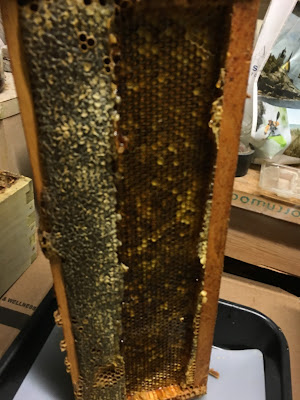I harvested from them in mid-July and just haven't posted about it until now.
We took about two boxes worth of honey off of the two hives. We actually removed two boxes from each hive, but many of the frames were not used so we only harvested the excess, amounting to two boxes. I wanted to leave each hive with one full super in addition to whatever they have stored in the bottom brood box so that they have a good chance going into winter.
I brought the honey home and used a spatula to scrape the honey off of the plastic and into my crushing pan. This was the messiest harvest ever. And the frames were really drippy. I put the dripping frames into another roasting pan and will use the honey that dripped off of them to feed any bees who need feeding going into winter.
You can see in the first frame that it was only partially filled with capped honey.
I used a spatula to scrape the honey into the crushing pan.
When I had crushed it all and put the pulverized wax into the filter buckets, I then let the bees clean it up. I always do this in my front yard so it's not right next to the beehives.

 Out in front of my house puts the house between the cleanup and the apiary. Mostly I am sure I am feeding bees from around the neighborhood (there are at least five beekeepers within a block of me).
Out in front of my house puts the house between the cleanup and the apiary. Mostly I am sure I am feeding bees from around the neighborhood (there are at least five beekeepers within a block of me).It is quite a party for the bees but at the end of the day the wax is clean, not at all sticky, and ready to put in the solar wax melter.










Linda - can you describe your process for processing the honey this way and your filter buckets. Also curious about the wax and how you process it.
ReplyDeleteIf you will search "crush and strain" on this blog, you'll find lots of posts. Also there is a video on how to do crush and strain in the list of videos on the right side bar. I haven't ever harvested from honey on foundation so this is my first post about this. I get a filter bucket set that is a bucket with a honey gate and three graduated filters from Brushy Mountain - all of the bee companies carry some version of this.
ReplyDeletePutting those "wet" frames out for cleanup by every stinging insect within 2-3 miles is an excellent way to spread disease and parasites (eg Varroa mites). That blizzard of bees, wasps, and yellow jackets is also great for public relations with the neighbors.
ReplyDeleteSo far the neighbors find it more an item of curiosity. They all know I have bees and having the buzzing bees in the front yard and my walking around not being stung could possibly be good publicity. People see bees as attacking and I'm there in the thick of it, not being attacked!
ReplyDeleteI harvested honey this way the past couple of years but I'm slinging it this year. Both methods are fun. Every beekeeper I know puts out their equipment to be cleaned by the bees and I've never heard anyone say not to do it. It would be a shame to wash it all and waste the honey.
ReplyDeleteI would much rather put it out for the bees. When I know that one bee in her lifetime only makes 1/4 tsp of honey, I can't bear to wash it down the drain. Putting it back on the hives to let them clean it means dripping honey in the hives and is an open invitation to robbing. This putting the frames in the front yard is the best way I know to allow bees to take the honey and keep my hives from being open house invitations to robbers. I don't think the backyard beekeeper is at all responsible for the spread of varroa. I do think that using poisons in the hive to keep varroa at bay is simply a way of breeding a stronger varroa mite. Since I don't use poisons in my hive and my bees live through the winter and I don't see signs of deformed wing or other virus infections, I will not buy that I am spreading varroa by putting my frames out for the bees to clean.
ReplyDelete